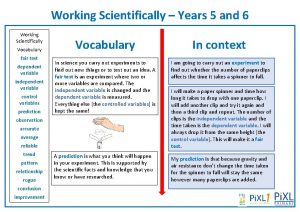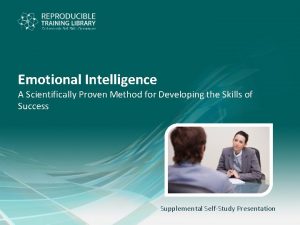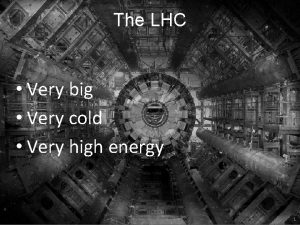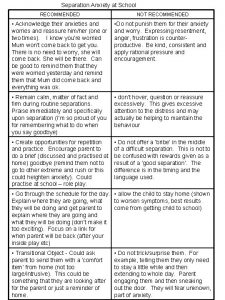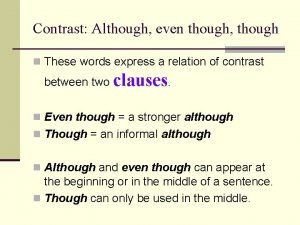HOMENOT VERY RECOMMENDED THOUGH EXPERIMENTS Though scientifically proven














- Slides: 14

HOME(NOT VERY RECOMMENDED THOUGH) EXPERIMENTS (Though scientifically proven to work, due to some impassable obstacles in daily lives e. g. Getting zinc and copper sulphate, I am not able to do the experiments, but they are scientifically proven to work, and have some uses) Mainly thought of it myself and check each reaction whether it corresponds correctly online.

Homemade liquid batteries � � This is a pretty handy experiment, and if done properly, you just made a battery that can last for years. The main ingredients is copper sulfate and zinc which you can get at your general stores. If you are planning to string up more than one battery, get more wires and those cheap electric ends(crocodile clips will be handy, and try to get a shape with a knob at the end for the zinc, it will make things easier. )

Things needed � � � A cup Any moderate ph level of acid Zinc and copper sulfate Wires Tap water(no pure water, since its an insulator) Insulated wires( as for the heads its up to you, though for the adapter you have to cut off the insulator and bind the right wires together)

Steps � � � � 1. Create zinc and copper electrodes from the materials. 2. Place the copper electrode on the bottom of a glass and cover it in copper sulphate till about half covered. 3. Fill the glass half full with water, and stir it till it gives a pleasing shade of blue. 4. (This is the hard part) Add more water to the top of it, but don’t let it mix into the mixture of copper sulphate and water. (one top is to use a dropper but drop the water just above the surface slowly, it will take time) 5. Now hang the zing electrode on top of the water, but don’t push into the blue portion. Attach the ends of the electrodes with wires, and bind it with the adapter. Add a drop or two of acid to jump start the battery.

Things to note � � 1. Never let the water mix into the blue portion 2. If the copper sulphate is running low just drop in more pieces, slowly. 3. PLEASE READ THIS BEFORE DOING THE EXPERIMENT, do the experiment where it will be used for it is almost impossible to shift it afterwards. 4. Demonstrations can be found on youtube.

Strike-anywhere matches � � � One warning, before using them, wear thick gloves and eye-wear. They can be used anywhere. Its best to use an extremely long stick when first doing this experiment, because if the mixture is too concentrated it will blow up.

Things you need � � � White glue(And LARGE amounts) Red phosphorus Potassium chlorate Oven Fire extinguisher(should it ever fail and start a fire) Safety glasses

Steps � � Mix the potassium chlorate and white glue together into a STIFF paste Roll the sticks end in the paste and bake in an oven at 150 Fahrenheit for 2 hours. Dip the baked head in a mixture of glue and red phosphorus. ( This is the igniter) Another round of baking and its done.

Things to note � � Before starting to use the matches, test one out in a place where it won’t make its surroundings catch fire. The reason is that when it is struck is that the mixtures are mixed together and the red phosphorus mixes with the potassium chlorate. The white glue was simply for keeping them apart and preserving it. (So don’t use white phosphorus in this experiment, I do not want to be held liable for any injuries)

Making perfect bullets � � This is just an add on, it will not work unless you can find a building about 60 -70 feet high where you can drops of molten lead down into water below. This bullets can be used in shotguns, and as they know, round pellets fly faster and straighter, but making one bullet in their own mold is not really mass production.

What you need � � � The location stated in the previous slide Tank of water Safety glasses Gloves Few pounds of molten lead in a pot sieve

Steps � � Go to the top of the building and pour the lead through the sieve into the water below Try to pour it at a constant rate.

Results and things to note � Try to keep the water at room temperature � The lead will be near perfect or perfect spheres due to almost zero gravity freefall. In space, its proven by the water which turn into a perfect sphere without gravity, same for any liquid. � Do not breathe in the lead by the way, do the melting outside in a well ventilated place.

THANKS FOR READING And yes, they do work------------------scientifically.
 Although in a sentence
Although in a sentence Scientifically minded people
Scientifically minded people When a financial gain accompanies a forgery
When a financial gain accompanies a forgery How to think scientifically
How to think scientifically Learner engages in scientifically oriented questions
Learner engages in scientifically oriented questions Speaking scientifically
Speaking scientifically Which scientifically investigable question is relational?
Which scientifically investigable question is relational? Scientific notation rules
Scientific notation rules Fewfewfewf
Fewfewfewf Receiving table/area
Receiving table/area Figure 10
Figure 10 Quantifiers food exercises
Quantifiers food exercises Can the triangles be proven congruent? if so, how?
Can the triangles be proven congruent? if so, how? Wisdom is proved right by her actions proverbs
Wisdom is proved right by her actions proverbs Misys tiger
Misys tiger

















